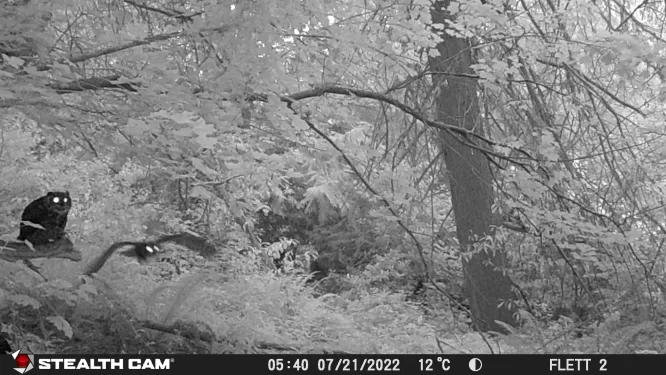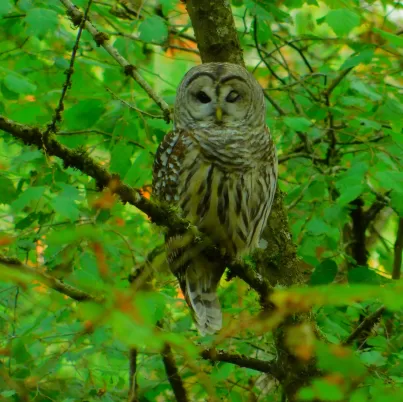Look Owl For Falling Sticks!
It’s Nesting Season!
by Marcia Wilson

Going outside in the Great Northwest is its own challenge. The snowpack looks great thanks to the rain, but humans going outside for fresh air and exercise are drawn to the slightly drier trails thick with conifer forest.
This is a good time to remember Great Horned Owls (or GHOs) prefer mature conifers because they sleep during the day and come out at night. Hard as it is to imagine, owls have predators too, and they need to be hidden when they are vulnerable. CPTC’s Outdoor Lab is a great place for a hunting ground. We have seen barred owls, barn owls, and Just Owls (when the thing doesn’t hold still long enough for positive ID). Thanks to the little ear-bumps, we’re 99.9% certain the trail camera picked up a Mom GHO with her baby.
Barn Owls scream like cougars, and Barred Owls are the primary source for Mothman sightings, but GHOs are hard to track. They can vanish and return without warning. Often, a sleepy whoo-hoo? is all we have for proof. Unlike many birds, they don’t build their nests at the same spot because they are very hard on their own décor. By the time the kids are ready to fly, there isn’t much left of home. So, off they go, and build next year’s nest ‘wherever’.

Disgruntled strigiformisphile scientists know the struggle to study GHOs. Dr. Faust had hopes of a long-term study on owl diets with regular dissection of the many, many owl pellets left thoughtfully behind. Environmental Science & Tech students dissect them every year in class. While owls are known to eat anything that moves, rat and vole are the overwhelming Dinner of Choice. Fine by us! A healthy predator population saves the world a lot of rodent control expenses.
Winter is the time for nest-building, so bird lovers watch where they walk; GHOs have very strong beaks and snip off evergreen bough tips to line their nests (about 4 inches/10.15 cms long, give or take). When they get really active, the trails can be sprinkled. If you’re strolling about, keep your eyes on the ground for those snipped-off boughs! You may also see ‘whitewash’ a white excrescence on the trees, feathers, and of course, owl pellets.
Don’t touch those. Let the scientists do that. Take photos if you see proof of wildlife on the college property…
…and don’t forget to tell Dr. Faust!
